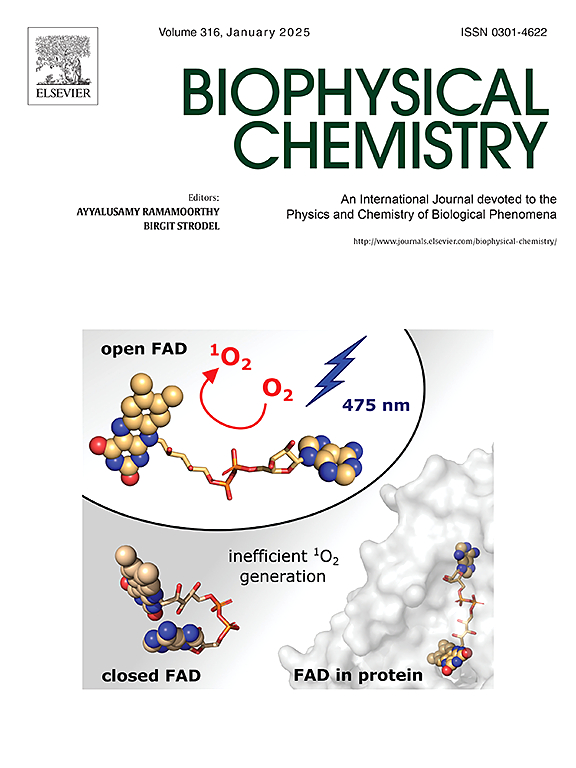Stability and conformation of DNA-hairpin in cylindrical confinement
IF 3.3
3区 生物学
Q2 BIOCHEMISTRY & MOLECULAR BIOLOGY
引用次数: 0
Abstract
We conducted atomistic Molecular Dynamics (MD) simulations of DNA-Hairpin molecules encapsulated within Single-Walled Carbon Nanotubes (SWCNTs) at a temperature of 300 K. Our investigation revealed that the structural integrity of the DNA-Hairpin can be maintained within SWCNTs, provided that the diameter of the SWCNT exceeds a critical threshold value. Conversely, when the SWCNT diameter falls below this critical threshold, the DNA-Hairpin undergoes denaturation, even at a temperature of 300 K. The DNA-Hairpin model we employed consisted of a 12-base pair stem and a 3-base loop, and we studied various SWCNTs with different diameters. Our analyses identified a critical SWCNT diameter of 3.39 nm at 300 K. Examination of key structural features, such as hydrogen bonds (H-bonds), van der Waals (vdW) interactions, and other inter-base interactions, demonstrated a significant reduction in the number of H-bonds, vdW energy, and electrostatic energies among the DNA hairpin's constituent bases when confined within narrower SWCNTs (with diameters of 2.84 nm and 3.25 nm). However, it was observed that the increased interaction energy between the DNA-Hairpin and the inner surface of narrower SWCNTs promoted the denaturation of the DNA-Hairpin. In-depth analysis of electrostatic mapping and hydration status further revealed that the DNA-Hairpin experienced inadequate hydration and non-uniform distribution of counter ions within SWCNTs having diameters below the critical value of 3.39 nm. Our inference is that the inappropriate hydration of counter ions, along with their non-uniform spatial distribution around the DNA hairpin, contributes to the denaturation of the molecule within SWCNTs of smaller diameters. For DNA-Hairpin molecules that remained undenatured within SWCNTs, we investigated their mechanical properties, particularly the elastic properties. Our findings demonstrated an increase in the persistence length of the DNA-Hairpin with increasing SWCNT diameter. Additionally, the stretch modulus and torsional stiffness of the DNA-Hairpin were observed to increase as a function of SWCNT diameter, indicating that confinement within SWCNTs enhances the mechanical flexibility of the DNA-Hairpin.

DNA 发夹在圆柱约束下的稳定性和构象。
我们对在 300 K 温度下封装在单壁碳纳米管(SWCNT)中的 DNA-Hairpin 分子进行了原子分子动力学(MD)模拟。我们的研究发现,只要单壁碳纳米管的直径超过临界阈值,DNA-Hairpin 的结构完整性就能在单壁碳纳米管中保持不变。相反,当 SWCNT 直径低于临界阈值时,DNA-Hairpin 会发生变性,即使在 300 K 的温度下也是如此。我们采用的 DNA-Hairpin 模型包括一个 12 碱基对的茎和一个 3 碱基环,我们研究了不同直径的 SWCNT。对氢键 (H-bonds)、范德华 (vdW) 相互作用和其他碱基间相互作用等关键结构特征的研究表明,当被限制在较窄的 SWCNT(直径为 2.84 nm 和 3.25 nm)中时,DNA 发夹的组成碱基之间的 H 键数量、vdW 能量和静电能量显著减少。不过,据观察,DNA 发夹与较窄的 SWCNT 内表面之间的相互作用能增加,促进了 DNA 发夹的变性。对静电映射和水合状态的深入分析进一步表明,DNA-Hairpin 在直径低于临界值 3.39 nm 的 SWCNT 中水合不充分,反离子分布不均匀。我们的推断是,反离子的不适当水合及其在 DNA 发夹周围的不均匀空间分布导致了分子在直径较小的 SWCNT 内变性。对于在 SWCNT 内保持未变性的 DNA 发夹蛋白分子,我们研究了它们的机械特性,尤其是弹性特性。我们的研究结果表明,DNA-Hairpin 的持续长度随着 SWCNT 直径的增加而增加。此外,我们还观察到 DNA-Hairpin 的拉伸模量和扭转刚度随 SWCNT 直径的增加而增加,这表明在 SWCNT 内的限制增强了 DNA-Hairpin 的机械灵活性。
本文章由计算机程序翻译,如有差异,请以英文原文为准。
求助全文
约1分钟内获得全文
求助全文
来源期刊

Biophysical chemistry
生物-生化与分子生物学
CiteScore
6.10
自引率
10.50%
发文量
121
审稿时长
20 days
期刊介绍:
Biophysical Chemistry publishes original work and reviews in the areas of chemistry and physics directly impacting biological phenomena. Quantitative analysis of the properties of biological macromolecules, biologically active molecules, macromolecular assemblies and cell components in terms of kinetics, thermodynamics, spatio-temporal organization, NMR and X-ray structural biology, as well as single-molecule detection represent a major focus of the journal. Theoretical and computational treatments of biomacromolecular systems, macromolecular interactions, regulatory control and systems biology are also of interest to the journal.
 求助内容:
求助内容: 应助结果提醒方式:
应助结果提醒方式:


